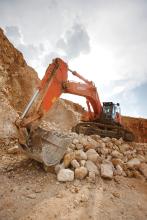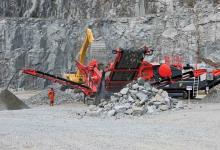
Cement is used in every aspect of construction from roads to housing. European companies operating in this capital intensive sector are also a force to be reckoned with globally. Alan Peterson reports
An important product of a quarry operation, cement plays a pivotal role in every aspect of building and civil engineering - from housing to road construction. Cement is not so much a star in its own right as a strong supporting act to concrete, the most universal of all construction materials.
To put it into perspective, the global cement industry produced an estimated 2.27 billion tonnes of cement in 2005, with about 45% of the total produced in China. But the EU is also a big producer with almost 250 million tonnes of cement manufactured in the region during the same 12 month period.
Although operating predominantly through regional markets, European cement companies are a force around the globe. Premier companies who dominate the European theatre include
However, in all markets where they operate, competition remains fundamentally local with each market being governed by its own specific characteristics and, as a result, not truly linked to others, according to CEMBUREAU. "There has been a lot of consolidation within Europe and there is still room for more compared to other capital intensive industries," said CEMBUREAU's Nathalie Timmerman.
Many of the larger cement producers own and operate their own quarries. Like many other key players, these groups have also branched out into building materials sub-sectors such as aggregates, concrete products and plasterboard, where they are also successful.
Capital intensive
The cost of cement plants is usually above €150million per million tonnes of annual capacity, with correspondingly high costs for modifications. This cost is equivalent to around three years of turnover, which ranks the cement industry among the most capital intensive. However, it is an industry with a low labour intensity.
Given that it draws its essential raw materials from the ground, cement tends to be an industry of the countryside. Today's typical medium to large plant needs less than 150 staff. In the EU, the cement industry directly employs 46,400 people, and is a prominent contributor to local and regional economies, supporting jobs in rural areas.
Price is the most important sales parameter next to customer service; quality premiums exist but are rather limited, according to CEMBUREAU.
Land transportation costs are significant. It used to be said that cement could not be economically hauled beyond 200, or at most, 300km. The cost of long road transportation may even be higher than the cost price. Bulk shipping has changed that, however, and it is now cheaper to cross the Atlantic Ocean with 35,000tonnes of cargo than to truck it 300km.
Consumption growth
Consumption of cement in the industrialised countries multiplied six to eight times following World War II. Growth continued steadily until the 1975 oil crisis - with a subsequent decline of 20 to 40% in mature markets.
However, over the last 25 years, some European countries, such as Greece, Portugal, Spain and Turkey, have doubled or even tripled their consumption.
In mature markets, where cement consumption per capita still varies considerably from one country to another, cement sales are dependent on evolution and habits in the construction sector, a sector that follows closely the evolution of the economy in general.
Given the importance of the initial capital investment involved in building a new plant, the cement industry is constantly investing to maintain the value of its plants, and in technical innovations, automation, the introduction of new processes and environmental protection.
EU standards
A wide variety of common cement products - 37 at least - exist in the different EU Member States. They match local manufacturing conditions, meeting particular climatic or other local conditions, including building practices.
Harmonised European standards regulate the placing of cement on the EU market and its free circulation within the EU.
The first EU harmonised product standard was issued in 2000. It was developed by CEN - "Comité Européen de Normalisation" (www.cenorm.be). Since April 2002, all common cements have been CE-marked according to EN 197-2. The CEN is currently
developing further technical standards for six other broad types of cement.
Top 10 Cement Producing Nations
| Nation | Production (incl exp/imp clinker ktonnes) | Consumption (Ktonnes) | Consumption (per capita kg) | Population (million) |
|---|---|---|---|---|
| China | 1,011,000 | 1,021,785 | 784 | 1303.97 |
| EU27 | 249,847 | 243,940 | 509 | 479.50 |
| India | 146,811 | 137,030 | 124 | 1100.69 |
| USA | 99,404 | 126,764 | 429 | 295.75 |
| Japan | 73,524 | 59,039 | 462 | 127,69 |
| Russia | 49,484 | 46,629 | 326 | 143.00 |
| korea | 49,139 | 46,283 | 979 | 47.26 |
| Turkey | 45,572 | 35,083 | 482 | 72.80 |
| Thailand | 37,872 | 22,157 | 340 | 65.22 |
| Brazil | 37,141 | 35,645 | 193 | 184.23 |
Environmental challenge
Historically, dust emissions were the main environmental concern. But those emissions have been reduced by 90% over the last 30 years, due to modern plant techniques.
But the industry faces big challenges over direct CO2 emissions. The industry is energy intensive: each tonne of cement produced requires 60 to 130kg of fuel oil or its equivalent, depending on the cement variety and the process used, and about 105KWh of electricity.
However, cement-making also necessitates the burning of fossil fuels which, with the raw materials themselves, then create emissions. Very high temperatures are needed to burn raw materials and give the clinker its unique properties. There are three measures by which the cement industry thinks it can save direct CO2 emissions in the immediate future:
• Improvement of energy efficiency (a maximum of 2% is still feasible).
• Reduction of clinker/cement ratio (introduction of useful industrial by-products).
• Increase in the use of waste as alternative fuel (national initiatives, adequate national implementation of certain directives regarding specific waste).
The cement industry contributes to about 3% of the total anthropogenic emissions of CO2 in the
"European cement production techniques are among the most energy efficient in the industrial world," argues CEMBUREAU.
Some believe the cement industry has now reached the limit of available technical means for further reductions. This is perhaps why it is turning to flexible and innovative solutions.
REACH
Of particular importance to the cement industry is the EU's REACH (Registration, Evaluation, and Authorisation of Chemicals) Regulation, which gives greater responsibility to industry to manage the risks from chemicals and to provide safety information on the substances. Manufacturers and importers will be required to gather information on the properties of their substances, which will help them manage them safely, and to register the information in a central database. A Chemicals Agency will act as the central point in the REACH system.
CEMBUREAU says that while the cement industry supports the basic aims of REACH it does not to have to be registered since cement is considered to be a preparation. But it does need to be classified and labelled when put onto the market and CEMBUREAU does have serious concerns about the REACH proposals.
"It (REACH) has been developed mainly with the objective of safe use of man-made products from the chemical industry. However, as currently presented, it would also cover other products such as those that our member companies manufacture, as well as our raw materials. We feel that including our raw materials and products in REACH under the same regime as chemicals, clearly cannot be the intention of the legislator."
Aware of the pressures to achieve sustainability, the cement industry has already moved to reduce the use of virgin raw materials by using by-products from other industries in the cement-making recipe. For example, pulverised fuel ash from power generation is widely used today. Waste streams containing high percentages of iron, alumina, calcium or silica may be used to replace the limestone and clay usually used in cement production. This avoids bulk waste materials going to landfill








